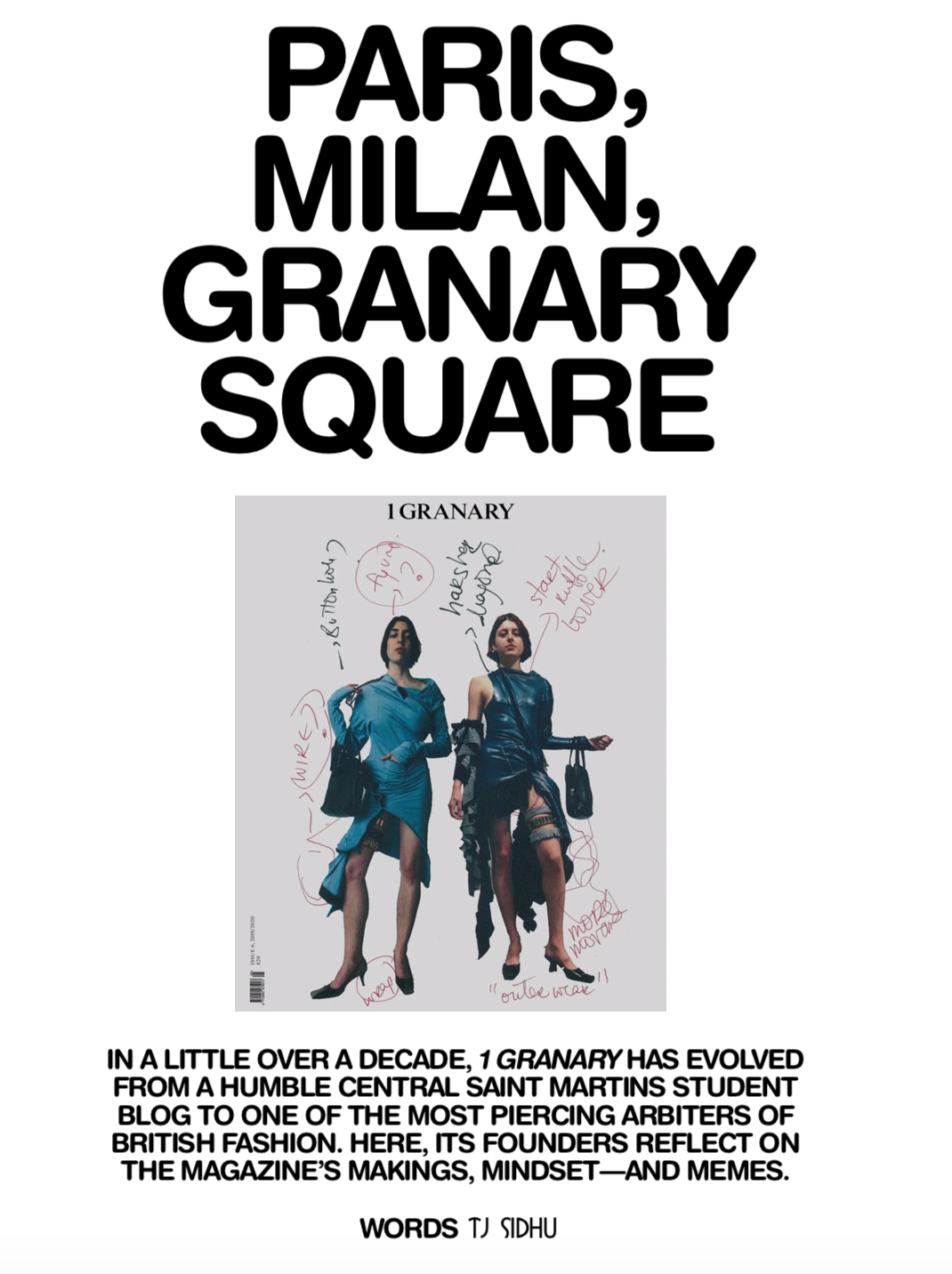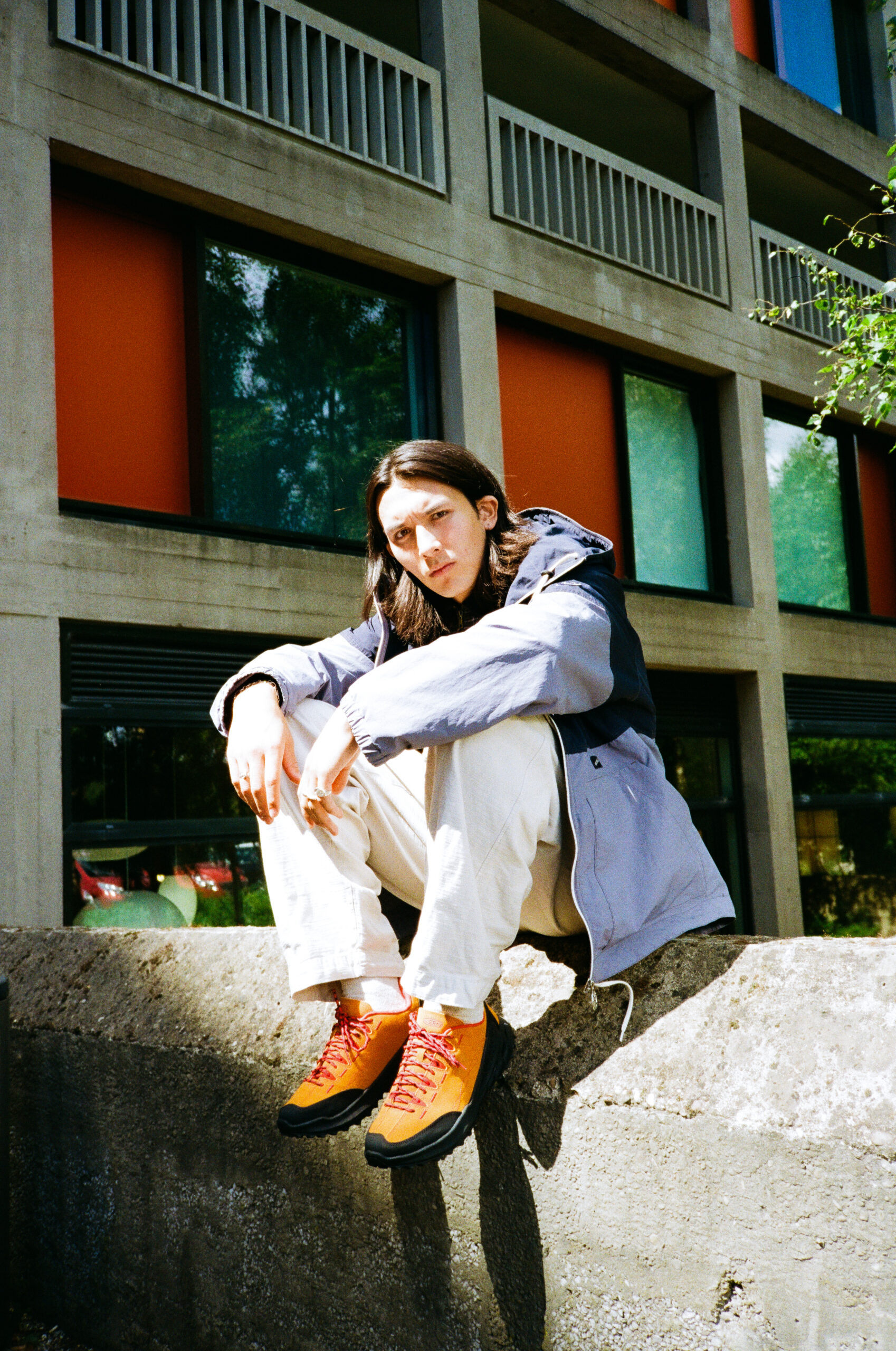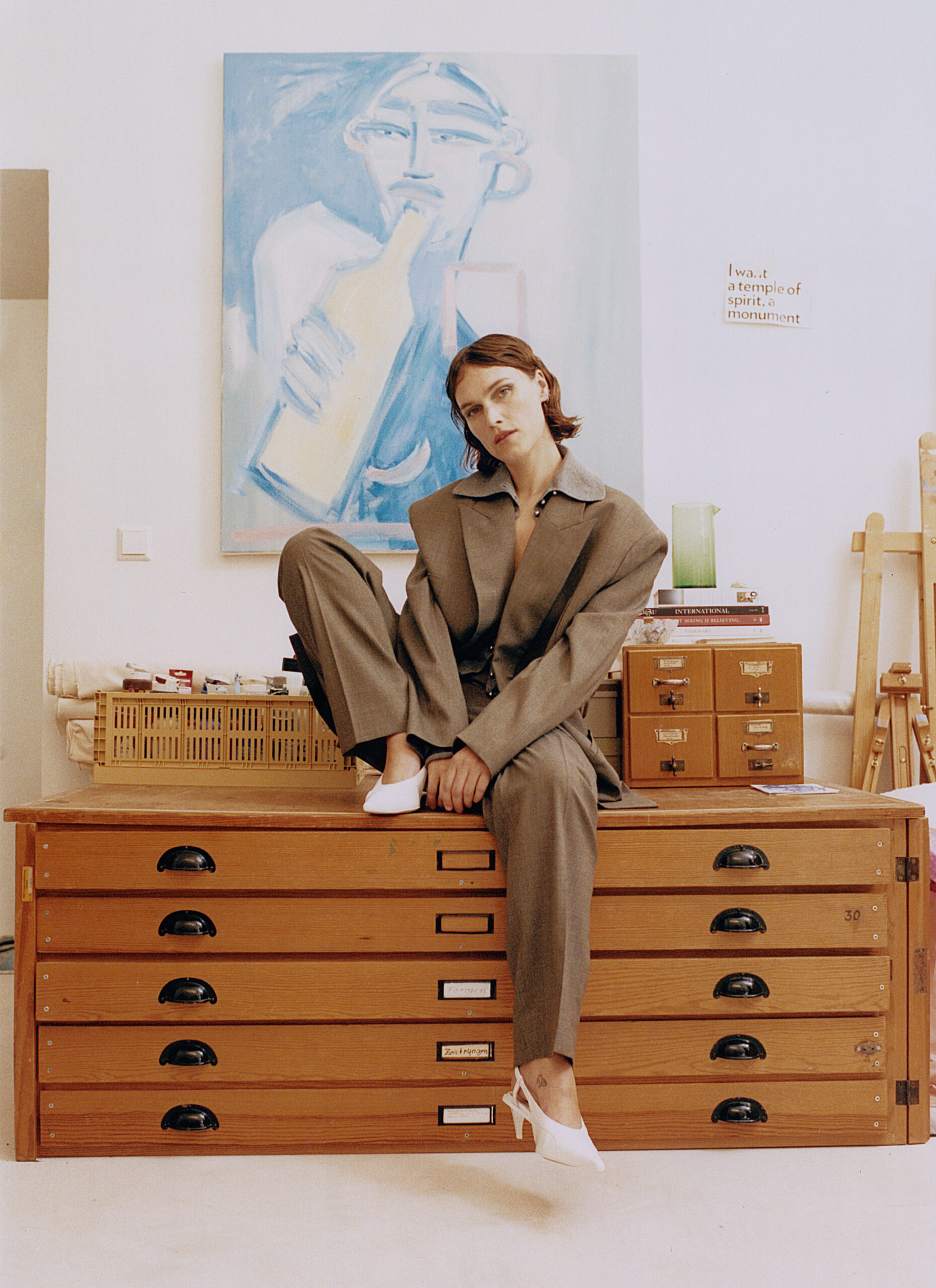IN A LITTLE OVER A DECADE, 1 GRANARY HAS EVOLVED FROM A HUMBLE CENTRAL SAINT MARTINS STUDENT BLOG TO ONE OF THE MOST PIERCING ARBITERS OF BRITISH FASHION. HERE, ITS FOUNDERS REFLECT ON THE MAGAZINE’S MAKINGS, MINDSET—AND MEMES.
Uncertain futures are to magazines what changing algorithms are to influencers: unpredictable, impactful, and a test of adaptability. In light of the rise of TikTokcore and the ever-expanding sea of online content, there is often a question mark over who—in this day and age—magazines are for. Whether the youth are still buying them, whether Instagram can compete, and the grim debate of whether AI will replace journalists altogether. This unpredictability is bolstered by the hard reality that, in the UK at least, the purchase of print titles has declined by 70 per cent between 2010 and 2022, from one billion to 309 million. Ouch.
A decade ago, however, there was a gap on newsagents’ shelves for a fashion magazine yet to exist. One that was by students, for students; a resource to discover the undiscovered, ready to sink its teeth into independent, critical journalism, not influenced by the ball and chain of the paying advertiser that established publications are so often limited by. While the celebrity-adorned covers of Vogue, the wink of i-D and London-ness of Dazed had long been established, there was need for a bit of anarchy: a magazine that was frank, provocative in its approach, and celebrated the lives and work of peers and friends over the biggest name.
When Olya Kurshchuk set up 1 Granary in 2012, in the middle of her fashion design studies at Central Saint Martins (CSM), she had no intention of establishing one of London’s leading platforms for nurturing the city’s roll-call of emerging fashion designers. Starting a magazine wasn’t even a thought. In fact, it was the last thing Kurshchuk wanted.
“I didn’t care or think about the fashion sphere,” Kurshchuk says, Zoom-ing in from a hotel room in Copenhagen just after 10pm. She rubs her eyes, having spent most of the day hopping from show to show at the city’s SS24 Fashion Week. “I started 1 Granary on a Tuesday, and on Wednesday there were two of us. A week later, there were 20 of us,” she explains of the platform’s humble beginnings as casual meet-ups in CSM’s buildings. It was an idea born out of Kurshchuk’s frustration, having moved to London from Kyiv, Ukraine, at not feeling as well-equipped for Saint Martins as her UK peers. “They all had friends who were a year or two above them, so they knew about projects in advance. When someone would say ‘Fashion East’, I was like, ‘Who?’ I’d never heard of Dazed before I moved to London.”
A little over a decade ago, 1 Granary was a hub for fashion students who felt the same as her. Named after its address on CSM’s campus around London’s Granary Square, it started as an online blog where one could openly ask questions—and get some much-needed answers—about the fashion industry: how to apply for internships, the best places to source fabrics in London, and industry names to know. Despite studying fashion at one of the most influential art schools in the world, the industry beyond the King’s Cross building still felt impenetrable.
“Tutors at CSM give you five minutes, if you’re lucky, twice a week,” Kurshchuk continues. “So through 1 Granary, we were able to sit for an hour and speak to a tutor, to understand how brands work, how to get a visa, things like that.”
Even at a university where almost a quarter of students come from overseas, Kurshchuk found there was little guidance for those who weren’t ‘in the know,’until she set it up herself. “If I were to ask someone to have a coffee with me, so I could ask them questions, they wouldn’t understand why,” she explains. “But once we had 1 Granary, everyone wanted to have a coffee and open up.” With no media plan or business model (“we didn’t even want a magazine!”), Kurshchuk was content with how things were running, with meet-ups at Saint Martins happening regularly. “We just wanted information at a time when we couldn’t find it. It was serving ourselves and our friends around us.”
Then came a bit of luck—and 1 Granary’s first foray into publishing. With the editorial shoots, features and interviews of its first issue complete, Kurshchuk received an email from Adrian Joffe, president of Comme des Garçons, who said he’d like to meet in Paris. It turned out a first-year student involved with 1 Granary was emailing (“pestering”) a salesperson at Dover Street Market.
“By that point, the magazine was done, so I brought it as A3 spreads. Usually people pitch an idea, but we brought 300 pages, laid out, written, shot—everything,” she says.
Three days later, Joffe followed up with a call. “I remember being in a cab and receiving the call saying Comme des Garçons will help fund it.” With Joffe’s support, 1 Granary would become the first publication CDG would fund in its entirety. Being students, this obviously helped get the project off the ground, lifting it from a self-funded university project to a bona fide magazine. “We only printed 1,000 issues, but [those issues] opened so many doors.” Once printed, it was time to distribute. All 1,000 issues were delivered by hand over three months. “It almost killed me.”
Priced at £12, the first issue clocked in at a mammoth 650 pages, its contents including a reissue of stylist and CSM alumni Katie Grand’s first-ever fashion editorial; an interview with Vogue’s then-fashion director and fellow CSM alumni Kate Phelan; and a cover featuring a model in tulle and a naked baby—no doubt alluding to the birth of the magazine.
There was never a plan for what 1 Granary would eventually become: a fully-fledged website in 2012 and its first print issue a year later. Its beginnings were—as with most student projects—DIY, but it was Kurshchuk’s autonomous spirit that shaped the publication into a respected platform capable of holding its own against long-established titles. Its biannual issues and online content echo Kurshchuk’s brilliant, no-bullshit tone: interviews are frank and honest, the less glamorous facets of working in fashion (unpaid internships, stylist returns, PRs on a power trip) readily exposed, and The Big Questions asked. For instance: “Why is Fashion Week so awkward?”
“The only constant since we started is curiosity. A need to grow and discover, and then observing the industry and responding to that,” says Aya Noël, 1 Granary’s online editor, joining the Zoom from her home in London. “Where most magazines have a fixed format, launching and coming out monthly or biannually and then growing from there, for us the format itself changes, as we look for different ways to answer to that curiosity—this need to understand the industry.”
Since those early days, 1 Granary has gone from an idea among students to a multi-faceted entity comprising a website, a hefty magazine and, of course, an Instagram account—the shining star of its galaxy, in some ways. Eschewing dull, lengthy posts, 1 Granary favours an internet-friendly approach: memes that essentially take the piss out of the revolving sartorial trends, existentialism and hysteria fashion can often land itself in. A smiling Kirsten Dunst, sunglasses on, sits on the back of a motorbike holding onto its rider. She is “the fashion industry”, the driver is “Phoebe Philo releasing a link.” In between are posts sharing students’ designs with captions of praise; bite-size fashion news headlines: “Christopher Kane is closing down his brand :(” ; and astute commentary on various brands getting it oh-so-wrong: Versace and Louis Vuitton being amongst the luxury houses having “cherry-picked motifs from sex work culture, capitalised on clichés and prioritised artifice over authenticity,” when discussing the absence of sex workers’ voices in an industry in which sex, historically, sells.
A conveyor belt of projects has kept them busy. In 2016, Kurshchuk, along with a team of 14 in-house and contributing editors, set up a London-based showroom representing 50-plus designers, that has since collaborated with luxury brands such as Gucci, Tom Ford and Valentino; hosted talks and workshops on sustainability, politics, independence and critique; and curated exhibitions bringing together then-emerging students and labels such as menswear duo Stefan Cooke, Paolina Russo and Loewe’s senior womenswear designer Rebecca Jeffs. In 2018, they collaborated on The Graduate Project, a fashion film with Showstudio featuring the works of designers Bianca Saunders, Camilla Damkjaer, Eftychia, Arnar Mar Jonsson and T/SEHNE. In 2020, 1 Granary partnered with Pinterest on ‘Designers to Hire,’ an online, visual resource that connects designers for hire with stylists, buyers and employers in the fashion industry.
But it is 2017’s launch of VOID—a hands-on initiative supporting young talent which culminated in a sold-out physical issue—that perhaps best exhibits 1 Granary’s hawk-like eye for new talent to watch out for, long before they fall into the hands of other fashion editors. Split into six individual zines, MA Fashion students were paired with established, sought-after photographers, stylists and art directors from across the industry. KNWLS worked with Harley Weir and Georgia Pendlebury (both of whom still work with the London-based brand, six years on), setting the visual tone of feminine sensuality in a series of subversive shots that emphasise the body–darkened corners and tough poses anticipating what was to come for Charlotte Knowles and Alexandre Arsenault’s cult label.
Chopova Lowena, who worked with Pop and Arena Homme+ creative director Ben Kelway, produced a surreal short film of mannequin-like models spinning around on turnstiles, hard-as-nails with hands firmly on hips, visors obstructing the eyes, and wearing early iterations of Emma Chopova and Laura Lowena’s beloved kilts (these days seen on the likes of Dua Lipa, Madonna and Olivia Rodrigo). Then, it was Sinead O’Dwyer’s turn, whose MA designs were interpreted by photographer Sharna Osborne and stylist Danielle Emerson; the long-time collaborators’ transgressive, club-kid influences shook up O’Dwyer’s sculptural final-year designs—authentically size-inclusive in its celebration of the human body—to a fizzy cocktail of joy, hedonism and attitude. This energy is still to be found in her more recent catwalk collections– she debuted at London Fashion Week in September 2022, as part of the British Fashion Council’s NEWGEN initiative.
For all of this to become possible, Kurshchuk and co. had to play with institutional boundaries, dipping their nibs into styling, photoshoots and other mediums that weren’t part and parcel of their respective degrees. “In CSM, you’re so limited,” Kurshchuk says. “If you do fashion print, then that’s the only thing you do. If you do womenswear, there’s no way for you to use the print room. So if you wanted to try styling, illustration or writing, you were so limited. We wanted to try different things.”
Armed with defiance, white IKEA bed sheets and some willing models, Kurshchuk started putting together editorials, mostly using students’ designs. Then, she came across a twelve-page zine in a Saint Martins’ print room, and had the idea to transform her shoots—that had until then largely lived on a 1 Granary blog—into a bona fide magazine and hand them out to students at the university, guerilla style.
“That started growing quite quickly, and we started building it as a magazine,” she says. “Aya knows I have this curse, that whenever I start something, somehow it really grows in size. A small zine will turn into 650 pages, or a little exhibition turns into six huge companies working with us.”
“She’s a very enthusiastic person!,” Noël adds.
“I’m telling you, if I was able to start a magazine, anyone can,” Kurshchuk says, dead serious. “For every email, I would write it in Russian because my flatmate was from Kyrgyzstan, and she would translate them into English and then I would send the email. My English wasn’t so good back then.”
Back in 2012, Instagram had only just taken off. The app then had 50 million users, compared to today’s one billion, and the possibility of instant, global reach, wasn’t nearly as dramatic as it is now. If 1 Granary was being set up today, would it be a case of Kurshchuk posting a Story, asking her peers if they’d like to meet once a week, as she did—IRL—over a decade ago?
“Maybe I’m delusional, but I feel like it’s easier to start now than back then. Everyone is so much more savvy now,” she says. “We were kind of just testing what would happen. There are examples of really smart people like Imran [Amed, founder of Business of Fashion] and Susie Bubble. As a student then, they were that small group of bloggers who managed to use it to their advantage. But the majority of us had no idea how to do it, and didn’t want to put ourselves out there. We were too shy!”
Given the uncertain (depressing) future of physical magazines, I ask Kurshchuk whether she’d bother mailing out 1,000 copies of 1 Granary copies by hand, if it were to be made today. “When it comes to brands and magazines, you have to have an angle that is original and you’re constantly thinking about why it needs to exist, instead of just doing it for the sake of it,” she says. “You have to have a point of view.”
1 Granary came at the perfect time. Word-of-mouth was a currency that had much more resonance than it does today, the pace wasn’t as gruelling as today’s constant churn culture and, importantly, it was a meeting place for Saint Martins’ next generation to congregate into one magazine. A far cry from the notions of art schools being bitchy, cut-throat and dog-eat-dog, 1 Granary was—and still is—a collaboration.
After over a decade, the magazine has remained happily independent. But while it, at times, sounds as though things merely fell into place for 1 Granary, it took a fair few sleepless nights along the way, too. True to form, Kurshchuk and Noël are quick to divulge the harsh realities of operating a business in fashion—a tricky subject the platform often addresses, to wipe away the gloss and make the realities of low pay and hard work clear to generation-next.
“When you’re independent, you need something to do it for,” Noël says. “I’m weighing my words a little because I’m very allergic to ‘just follow your dream’ narratives from people who speak about a startup or any business— those are very vague terms. But what you do need is enthusiasm and excitement; the things you see and touch that motivates you.”
“At one point, we were stealing toilet paper from coffee shops because we couldn’t afford it,” Kurshchuk says. “I’d never had a ‘dream.’ But at some point, doing 1 Granary felt like the only method of survival. It either worked or I was going back home [to Kyiv]. There was a lot of stress. We’re in a great place. I feel very, very fulfilled.”
Over ten-plus years, 1 Granary has become a trusted voice for emerging fashion talent in art schools around the globe, building water-tight relationships with institutions such as the Royal Academy of Art, Parsons, Fashion Institute of Technology and Polimoda. And the platform’s influence has helped elevate how the industry sees graduate designers, and students yet to even graduate, from an afterthought to review-worthy. Talent has always been there, but with 1 Granary’s fine-tuning, its advocacy for young talent and determined questioning of rights and wrongs, the British fashion industry has certainly learnt a thing or two.
With a decade over and done with, what do the next ten years look like?
“On a journey to becoming huge. And I don’t mean as a media, but as the company and the things we are doing, I think we are on the right path,” Kurshchuk says.
“Maybe we’ve been staring at your poster for too long,” says Noël, referring to the Michael Clark Company print hung up behind me, with a giant cock drawn over its lime green background, “because I was also going to say huge.”



